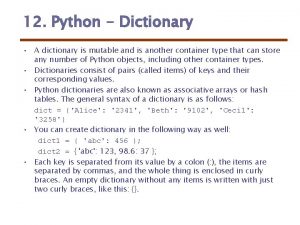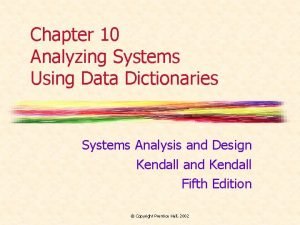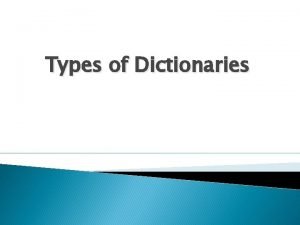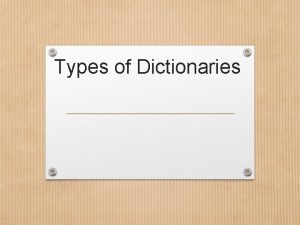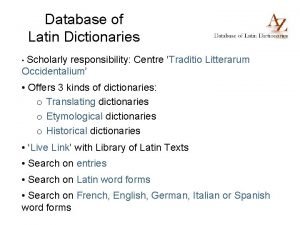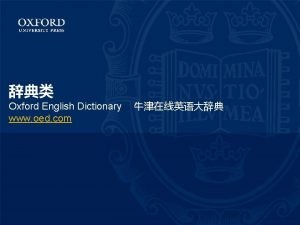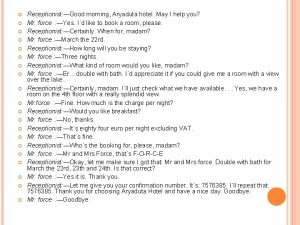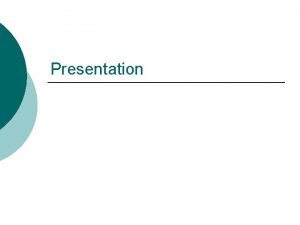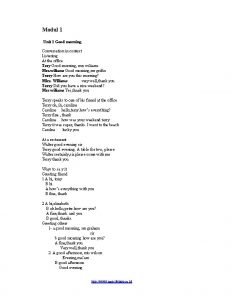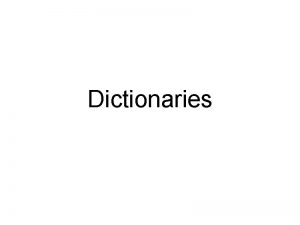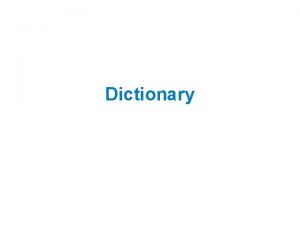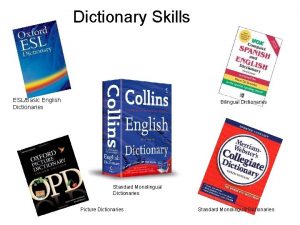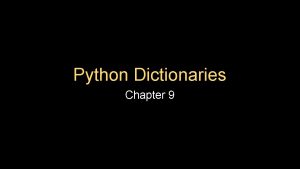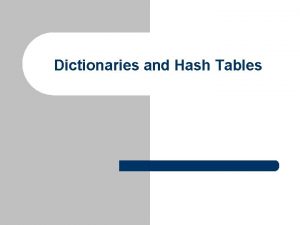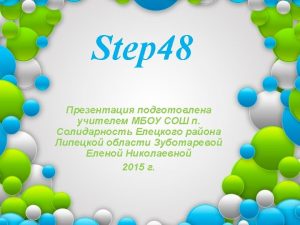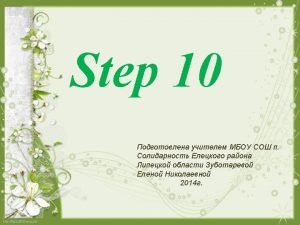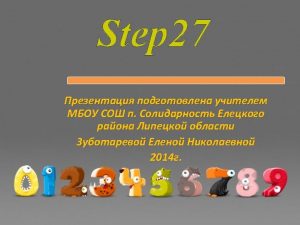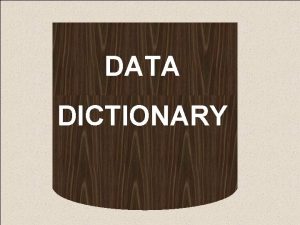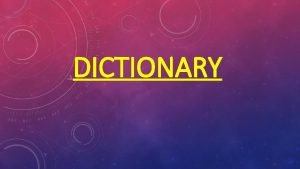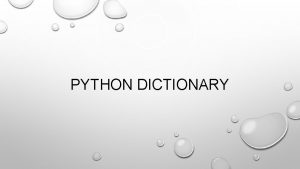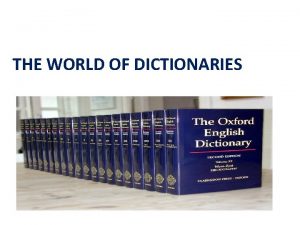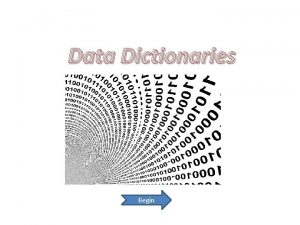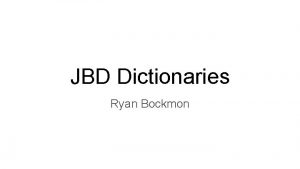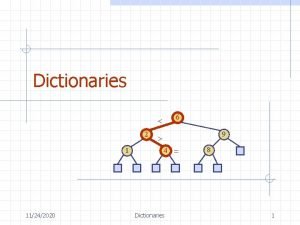Dictionaries A Good morning dictionary English Good morning








![Add new elements >>> >>> len >>> my_sister = {} my_sister["name"] = "Christy" print Add new elements >>> >>> len >>> my_sister = {} my_sister["name"] = "Christy" print](https://slidetodoc.com/presentation_image_h2/a4b25037f31e6cb0419dcc13249afaf2/image-9.jpg)

![A few more examples >>> D = {"name": "Johann", "city": "Cape Town"} >>> counts["city"] A few more examples >>> D = {"name": "Johann", "city": "Cape Town"} >>> counts["city"]](https://slidetodoc.com/presentation_image_h2/a4b25037f31e6cb0419dcc13249afaf2/image-11.jpg)







![Listing Codons >>> seq = "TCTCCAAGACGCATCCCAGTG" >>> seq[0: 3] 'TCT' >>> seq[3: 6] 'CCA' Listing Codons >>> seq = "TCTCCAAGACGCATCCCAGTG" >>> seq[0: 3] 'TCT' >>> seq[3: 6] 'CCA'](https://slidetodoc.com/presentation_image_h2/a4b25037f31e6cb0419dcc13249afaf2/image-19.jpg)
















- Slides: 35

Dictionaries

A “Good morning” dictionary English: Good morning Spanish: Buenas días Swedish: God morgon German: Guten morgen Venda: Ndi matscheloni Afrikaans: Goeie môre

What’s a dictionary? A dictionary is a table of items. Each item has a “key” and a “value” Keys Values English Good morning Spanish Buenas días Swedish God morgon German Guten morgen Venda Ndi matscheloni Afrikaans Goeie môre

Look up a value I want to know “Good morning” in Swedish. Step 1: Get the “Good morning” table Keys Values English Good morning Spanish Buenas días Swedish God morgon German Guten morgen Venda Ndi matscheloni Afrikaans Goeie môre

Find the item Step 2: Find the item where the key is “Swedish” Keys Values English Good morning Spanish Buenas días Swedish God morgon German Guten morgen Venda Ndi matscheloni Afrikaans Goeie môre

Get the value Step 3: The value of that item is how to say “Good morning” in Swedish -- “God morgon” Keys Values English Good morning Spanish Buenas días Swedish God morgon German Guten morgen Venda Ndi matscheloni Afrikaans Goeie môre

In Python >>>. . . . >>> God >>> good_morning_dict = { "English": "Good morning", "Swedish": "God morgon", "German": "Guten morgen", "Venda": "Ndi matscheloni", } print good_morning_dict["Swedish"] morgon (I left out Spanish and Afrikaans because they use ‘special’ characters. Those require Unicode, which I’m not going to cover. )

Dictionary examples >>> D 1 = {} >>> len(D 1) 0 >>> D 2 = {"name": "Andrew", "age": 33} >>> len(D 2) 2 >>> D 2["name"] 'Andrew' >>> D 2["age"] 33 >>> D 2["AGE"] Traceback (most recent call last): File "<stdin>", line 1, in ? Key. Error: 'AGE' >>> An empty dictionary A dictionary with 2 items Keys are case-sensitive
![Add new elements len mysister mysistername Christy print Add new elements >>> >>> len >>> my_sister = {} my_sister["name"] = "Christy" print](https://slidetodoc.com/presentation_image_h2/a4b25037f31e6cb0419dcc13249afaf2/image-9.jpg)
Add new elements >>> >>> len >>> my_sister = {} my_sister["name"] = "Christy" print "len =", len(my_sister), "and value is", my_sister = 1 and value is {'name': 'Christy'} my_sister["children"] = ["Maggie", "Porter"] print "len =", len(my_sister), "and value is", my_sister = 2 and value is {'name': 'Christy', 'children': ['Maggie', 'Porter']}

Get the keys and values >>> city = {"name": "Cape Town", "country": "South Africa", . . . "population": 2984000, "lat. ": -33. 93, "long. ": 18. 46} >>> print city. keys() ['country', 'long. ', 'lat. ', 'name', 'population'] >>> print city. values() ['South Africa', 18. 460000001, -33. 93, 'Cape Town', 2984000] >>> for k in city: . . . print k, "=", city[k]. . . country = South Africa long. = 18. 46 lat. = -33. 93 name = Cape Town population = 2984000 >>>
![A few more examples D name Johann city Cape Town countscity A few more examples >>> D = {"name": "Johann", "city": "Cape Town"} >>> counts["city"]](https://slidetodoc.com/presentation_image_h2/a4b25037f31e6cb0419dcc13249afaf2/image-11.jpg)
A few more examples >>> D = {"name": "Johann", "city": "Cape Town"} >>> counts["city"] = "Johannesburg" >>> print D {'city': 'Johannesburg', 'name': 'Johann'} >>> del counts["name"] >>> print D {'city': 'Johannesburg'} >>> counts["name"] = "Dan" >>> print D {'city': 'Johannesburg', 'name': 'Dan'} >>> D. clear() >>> print D {} >>>

Ambiguity codes Sometimes DNA bases are ambiguous. Eg, the sequencer might be able to tell that a base is not a G or T but could be either A or C. The standard (IUPAC) one-letter code for DNA includes letters for ambiguity. M is A or C Y is C or T D is A, G or T R is A or G K is G or T B is C, G or T W is A or T V is A, C or G N is G, A, T or C S is C or G H is A, C or T

Count Bases #1 This time we’ll include all 16 possible letters >>> seq = "TKKAMRCRAATARKWC" >>> A = seq. count("A") >>> B = seq. count("B") >>> C = seq. count("C") >>> D = seq. count("D") >>> G = seq. count("G") >>> H = seq. count("H") >>> K = seq. count("K") >>> M = seq. count("M") >>> N = seq. count("N") >>> R = seq. count("R") Don’t do this! Let the computer help out >>> S = seq. count("S") >>> T = seq. count("T") >>> V = seq. count("V") >>> W = seq. count("W") >>> Y = seq. count("Y") >>> print "A =", A, "B =", B, "C =", C, "D =", D, "G =", G, "H =", H, "K =", K, "M =", M, "N =", N, "R =", R, "S =", S, "T =", T, "V =", V, "W =", W, "Y =", Y A = 4 B = 0 C = 2 D = 0 G = 0 H = 0 K = 3 M = 1 N = 0 R = 3 S = 0 T = 2 V = 0 W = 1 Y = 0 >>>

Count Bases #2 Using a dictionary >>> seq = "TKKAMRCRAATARKWC" >>> counts = {} >>> counts["A"] = seq. count("A") >>> counts["B"] = seq. count("B") >>> counts["C"] = seq. count("C") >>> counts["D"] = seq. count("D") >>> counts["G"] = seq. count("G") >>> counts["H"] = seq. count("H") >>> counts["K"] = seq. count("K") Don’t do this either! >>> counts["M"] = seq. count("M") >>> counts["N"] = seq. count("N") >>> counts["R"] = seq. count("R") >>> counts["S"] = seq. count("S") >>> counts["T"] = seq. count("T") >>> counts["V"] = seq. count("V") >>> counts["W"] = seq. count("W") >>> counts["Y"] = seq. count("Y") >>> print counts {'A': 4, 'C': 2, 'B': 0, 'D': 0, 'G': 0, 'H': 0, 'K': 3, 'M': 1, 'N': 0, 'S': 0, 'R': 3, 'T': 2, 'W': 1, 'V': 0, 'Y': 0} >>>

Count Bases #3 use a for loop >>> >>>. . . >>> seq = "TKKAMRCRAATARKWC" counts = {} for letter in "ABCDGHKMNRSTVWY": counts[letter] = seq. count(letter) print counts {'A': 4, 'C': 2, 'B': 0, 'D': 0, 'G': 0, 'H': 0, 'K': 3, 'M': 1, 'N': 0, 'S': 0, 'R': 3, 'T': 2, 'W': 1, 'V': 0, 'Y': 0} >>> for base in counts. keys(): . . . print base, "=", counts[base]. . . A = 4 C = 2 B = 0 D = 0 G H K M N = = = 0 0 3 1 0 S R T W V Y = = = 0 3 2 1 0 0 >>>

Count Bases #4 Suppose you don’t know all the possible bases. If the base isn’t a key in the counts dictionary then use zero. Otherwise use the value from the dict >>> seq = "TKKAMRCRAATARKWC" >>> counts = {} >>> for base in seq: . . . if base not in counts: . . . n = 0. . . else: . . . n = counts[base]. . . counts[base] = n + 1. . . >>> print counts {'A': 4, 'C': 2, 'K': 3, 'M': 1, 'R': 3, 'T': 2, 'W': 1} >>>

Count Bases #5 (Last one!) The idiom “use a default value if the key doesn’t exist” is very common. Python has a special method to make it easy. >>> seq = "TKKAMRCRAATARKWC" >>> counts = {} >>> for base in seq: . . . counts[base] = counts. get(base, 0) + 1. . . >>> print counts {'A': 4, 'C': 2, 'K': 3, 'M': 1, 'R': 3, 'T': 2, 'W': 1} >>> counts. get("A", 9) 4 >>> counts["B"] Traceback (most recent call last): File "<stdin>", line 1, in ? Key. Error: 'B' >>> counts. get("B", 9) 9 >>>

Reverse Complement >>> complement_table = {"A": "T", "T": "A", "C": "G", "G": "C"} >>> seq = "CCTGTATT" >>> new_seq = [] >>> for letter in seq: . . . complement_letter = complement_table[letter]. . . new_seq. append(complement_letter). . . >>> print new_seq ['G', 'A', 'C', 'A', 'T', 'A'] >>> new_seq. reverse() >>> print new_seq ['A', 'T', 'A', 'C', 'A', 'G'] >>> print "". join(new_seq) AATACAGG >>>
![Listing Codons seq TCTCCAAGACGCATCCCAGTG seq0 3 TCT seq3 6 CCA Listing Codons >>> seq = "TCTCCAAGACGCATCCCAGTG" >>> seq[0: 3] 'TCT' >>> seq[3: 6] 'CCA'](https://slidetodoc.com/presentation_image_h2/a4b25037f31e6cb0419dcc13249afaf2/image-19.jpg)
Listing Codons >>> seq = "TCTCCAAGACGCATCCCAGTG" >>> seq[0: 3] 'TCT' >>> seq[3: 6] 'CCA' >>> seq[6: 9] 'AGA' >>> range(0, len(seq), 3) [0, 3, 6, 9, 12, 15, 18] >>> for i in range(0, len(seq), 3): . . . print "Codon", i/3, "is", seq[i: i+3]. . . Codon 0 is TCT Codon 1 is CCA Codon 2 is AGA Codon 3 is CGC Codon 4 is ATC Codon 5 is CCA Codon 6 is GTG >>>

The last “codon” >>> seq = "TCTCCAA" >>> for i in range(0, len(seq), 3): . . . print "Base", i/3, "is", seq[i: i+3]. . . Base 0 is TCT Base 1 is CCA Base 2 is A >>> Not a codon! What to do? It depends on what you want. But you’ll probably want to know if the sequence length isn’t divisible by three.

The ‘%’ (remainder) operator >>> 0 >>> 1 >>> 2 >>> 0 % 3 1 % 3 2 % 3 3 % 3 4 % 3 5 % 3 6 % 3 >>> seq = "TCTCCAA" >>> len(seq) 7 >>> len(seq) % 3 1 >>>

Two solutions First one -- refuse to do it if len(seq) % 3 != 0: # not divisible by 3 print "Will not process the sequence" else: print "Will process the sequence" Second one -- skip the last few letters Here I’ll adjust the length >>> seq = "TCTCCAA" >>> for i in range(0, len(seq) - len(seq)%3, 3): . . . print "Base", i/3, "is", seq[i: i+3]. . . Base 0 is TCT Base 1 is CCA >>>

Counting codons >>> seq = "TCTCCAAGACGCATCCCAGTG" >>> codon_counts = {} >>> for i in range(0, len(seq) - len(seq)%3, 3): . . . codon = seq[i: i+3]. . . codon_counts[codon] = codon_counts. get(codon, 0) + 1. . . >>> codon_counts {'ATC': 1, 'GTG': 1, 'TCT': 1, 'AGA': 1, 'CCA': 2, 'CGC': 1} >>> Notice that the codon_counts dictionary elements aren’t sorted?

Sorting the output People like sorted output. It’s easier to find “GTG” if the codon table is in order. Use keys to get the dictionary keys then use sort to sort the keys (put them in order). >>> codon_counts = {'ATC': 1, 'GTG': 1, >>> codons = codon_counts. keys() >>> print codons 'TCT': 1, 'AGA': 1, 'CCA': 2, 'CGC': 1} ['ATC', 'GTG', 'TCT', 'AGA', 'CCA', 'CGC'] >>> codons. sort() >>> print codons ['AGA', 'ATC', 'CCA', 'CGC', 'GTG', 'TCT'] >>> for codon in codons: . . . print codon, "=", codon_counts[codon]. . . AGA ATC CCA CGC GTG TCT >>> = = = 1 1 2 1 1 1

Exercise 1 - letter counts Ask the user for a sequence. The sequence may include ambiguous codes (letters besides A, T, C or G). Use a dictionary to find the number of times each letter is found. Note: your output may be in a different order than mine. Test case #1 Test case #2 Enter DNA: ACRSAS A = 2 C = 1 R = 2 S = 2 Enter DNA: TACATCGATGCWACTN A = 4 C = 4 G = 2 N = 1 T = 4 W = 1

Exercise 2 Modify your program from Exercise 1 to find the length and letter counts for each sequence in /usr/coursehome/dalke/ambiguous_sequences. seq It is okay to print the base counts in a different order. The first three sequences Sequence has 1267 bases A = 287 C = 306 B = 1 G = 389 R = 1 T = 282 Y = 1 Sequence has 553 bases A = 119 C = 161 T = 131 G = 141 N = 1 Sequence has 1521 bases A = 402 C = 196 T = 471 G = 215 N = 237 The last three sequences Sequence has 1285 bases A = 327 Y = 1 C = 224 T = 371 G = 362 Sequence has 570 bases A = 158 C = 120 T = 163 G = 123 N = 6 Sequence has 1801 bases C = 376 A = 465 S = 1 T = 462 G = 497

Exercise 3 Modify your program from Exercise 2 so the base counts are printed in alphabetical order. (Use the keys method of the dictionary to get a list, then use the sort method of the The first sequence output should write list. ) Sequence has 1267 bases A = 287 B = 1 C = 306 G = 389 R = 1 T = 282 Y = 1

Exercise 4 Write a program to count the total number of bases in all of the sequences in the file /usr/coursehome/dalke/ambiguous_sequences. seq and the total number of each base found, in order Here’s what I got. Am I right? File has 24789 bases A = 6504 B = 1 C = 5129 D = 1 G = 5868 K = 1 M = 1 N = 392 S = 2 R = 3 T = 6878 W = 1 Y = 8

Exercise 5 Do the same as exercise 4 but this time use /coursehome/dalke/sequences. seq Compare your results with someone else. Then try /coursehome/dalke/many_sequences. seq Compare results then compare how long it took the program to run. (See note on next page. )

How long did it run? You can ask Python for the current time using the datetime module we talked about last week. >>> import datetime >>> start_time = datetime. now() >>> # put the code to time in here >>> end_time = datetime. now() >>> print end_time - start_time 0: 09. 335842 >>> This means it took me 9. 3 seconds to write third and fourth lines.

Exercise 6 Write a program which prints the reverse complement of each sequence from the file /coursehome/dalke/10_sequences. seq This file contains only A, T, C, and G letters.

Exercise 7 Modify the program from Exercise 6 to find the reverse complement of an ambiguous DNA sequence. (See next page for the data table. ) Test it against /coursehome/dalke/sequences. seq Compare your results with someone else. To do that, run the program from the unix shell and have it save your output to a file. Compare using ‘diff’. python your_file. py > output. dat diff output. dat /coursehome/surname/output. dat

Ambiguous complements ambiguous_dna_complement = { "A": "T", "C": "G", "G": "C", "T": "A", "M": "K", "R": "Y", "W": "W", "S": "S", "Y": "R", "K": "M", "V": "B", "H": "D", "D": "H", "B": "V", "N": "N", } This is also the file /coursehome/dalke/complements. py

Translate DNA into protein Write a program to ask for a DNA sequence. Translate the DNA into protein. (See next page for the codon table to use. ) When the codon doesn’t code for anything (eg, stop codon), use “*”. Ignore the extra bases if the sequence length is not a multiple of 3. Decide how you want to handle ambiguous codes. Come up with your own test cases. Compare your results with someone else or with a web site.

Standard codon table This is also in the file /usr/coursehome/dalke/codon_table. py table = { 'TTT': 'TCC': 'TGT': 'CTA': 'CCG': 'CGT': 'ATC': 'ACA': 'AAG': 'GTT': 'GCC': 'GAA': 'GGG': 'F', 'S', 'C', 'L', 'P', 'R', 'I', 'T', 'K', 'V', 'A', 'E', 'G', 'TTC': 'TCA': 'TGC': 'CTG': 'CAT': 'CGC': 'ATA': 'ACG': 'AGT': 'GTC': 'GCA': 'GAG': } 'F', 'S', 'C', 'L', 'H', 'R', 'I', 'T', 'S', 'V', 'A', 'E', 'TTA': 'TCG': 'TGG': 'CCT': 'CAC': 'CGA': 'ATG': 'AAT': 'AGC': 'GTA': 'GCG': 'GGT': 'L', 'S', 'W', 'P', 'H', 'R', 'M', 'N', 'S', 'V', 'A', 'G', # Extra data in case you want it. stop_codons = [ 'TAA', 'TAG', 'TGA'] start_codons = [ 'TTG', 'CTG', 'ATG'] 'TTG': 'TAT': 'CTT': 'CCC': 'CAA': 'CGG': 'ACT': 'AAC': 'AGA': 'GTG': 'GAT': 'GGC': 'L', 'Y', 'L', 'P', 'Q', 'R', 'T', 'N', 'R', 'V', 'D', 'G', 'TCT': 'TAC': 'CTC': 'CCA': 'CAG': 'ATT': 'ACC': 'AAA': 'AGG': 'GCT': 'GAC': 'GGA': 'S', 'Y', 'L', 'P', 'Q', 'I', 'T', 'K', 'R', 'A', 'D', 'G',
 Como te llamas in spanish
Como te llamas in spanish Teacher good morning class
Teacher good morning class Teacher good morning students
Teacher good morning students Good morning and welcome back
Good morning and welcome back Good night i am glad to see you
Good night i am glad to see you Good morning hi
Good morning hi Good afternon animado
Good afternon animado Python mutable dict
Python mutable dict Example of data dictionary in system analysis and design
Example of data dictionary in system analysis and design Kinds of dictionary
Kinds of dictionary Types of dictionaries
Types of dictionaries Types of dictionaries
Types of dictionaries Database of latin dictionaries
Database of latin dictionaries Good morning hello
Good morning hello Jie-hong roland jiang
Jie-hong roland jiang Oed abbreviations
Oed abbreviations Good morning ladies and gents
Good morning ladies and gents Good charlotte
Good charlotte Good morning good lookin
Good morning good lookin Good morning students images
Good morning students images Good evening ladies and gentlemen we are now
Good evening ladies and gentlemen we are now Good deeds good thoughts good words
Good deeds good thoughts good words If you are
If you are No one loves me
No one loves me Morning bells are ringing
Morning bells are ringing Hello song
Hello song Another way to say good morning
Another way to say good morning Receptionist good morning
Receptionist good morning Good morning welcome home
Good morning welcome home Assalamualaikum good morning
Assalamualaikum good morning Good morning 1 june
Good morning 1 june Ladies and gentlemen it my pleasure to introduce to you
Ladies and gentlemen it my pleasure to introduce to you Good morning conversation
Good morning conversation Hello everyone i hope you are doing well
Hello everyone i hope you are doing well Good morning welcome june
Good morning welcome june Good morning campers today's challenge is simple
Good morning campers today's challenge is simple







